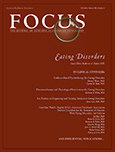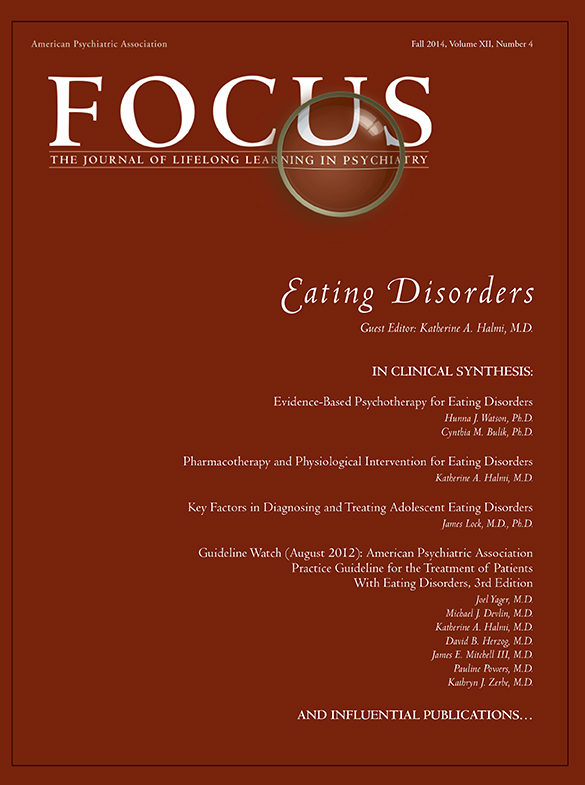Introduction
Three extensive reviews of evidence based treatment from randomized controlled trials (RCTs) for the three major eating disorders, anorexia nervosa (AN), bulimia nervosa (BN), and binge eating disorder (BED) have indicated that exclusive pharmacotherapy is not the preferred first line of treatment (
1–
3). According to FDA personnel, only one drug is approved for treating eating disorders and that is fluoxetine for treatment of BN.
It has not been possible to conduct adequate pharmacological RCTs in AN patients for several reasons. Their extreme fear of gaining weight makes them reluctant to enter trials (small samples), drop out of trials, and be noncompliant with protocol (ingesting the drug). The disparity of methodologies in the few RCTs that exist and the fact that of the two olanzapine trials that measured serum drug levels only one reported actual levels (
4,
5), preclude any justified conclusion by meta-analyses.
For BN and BED, adequate sample size and methodologically correct conducted trials make it possible to formulate some guidelines for pharmacological treatment. However, other than the FDA approval for fluoxetine to treat BN, no pharmaceutical company has conducted sufficient studies to obtain FDA approval for other medications to treat eating disorders.
What is evidenced based? The World Federation of Society of Biological Psychiatry (WFSBP) produced a categorized definition (
6) which is summarized in
Table 1. This is a helpful guide when applied to the core symptoms of a disorder as presented in the article by Aigner et al. (
7) concerning eating disorders. The three major eating disorders have high comorbidity with depressive, anxiety, and substance abuse disorders for which drug treatment may also affect core eating disorder symptoms (
8,
9). This article will focus on medications and physiological interventions assessed in the treatment of core eating disorder symptoms.
Pharmacotherapy and Physiological Interventions for Anorexia Nervosa
The major treatment guidelines based on extensive reviews all recommend a multidimensional approach with nutritional rehabilitation, cognitive behavioral therapy, and family therapy (especially for adolescents) for treating AN (
1–
3,
10). The major goals to be obtained are weight gain, change in eating behavior, significant reduction of mental preoccupations of body image and food, reductions of depression, and treatment of medical conditions such as osteoporosis. Examination of the 20 drug RCTs for AN reveals no drug was able to “cure” or substantially improve this disorder. There is no Category A evidence for any drug for treating AN. Thus, medications need to be considered an adjunct in treating AN.
There is category B evidence for two substances. Zinc supplementation was superior to a placebo in three double blind RCTs for weight gain (
11–
13). The recommended dose is 14 mg of elemental zinc orally for two months. An advantage of zinc is that patients do not think it is a weight-inducing drug and thus they are more likely to ingest it.
Olanzapine was effective for inducing weight gain in two double blind placebo RCTs (
5,
14) and had no difference from placebo in two other trials (
4,
15). Olanzapine reduced obsessive symptoms in the two studies that demonstrated an effect for weight gain (
5,
14). One of those studies (
5) was the only published olanzapine study that produced actual serum levels of the drug. In all studies the drug dose ranged from 2.5 to 10 mg and the duration of the studies ranged from 8 to 12 weeks. Olanzapine was well tolerated in all studies. Since AN patients know olanzapine is associated with weight gain, they refuse to take the drug. For those who agree to take olanzapine, serum drug levels may be necessary to ensure compliance.
For all other antipsychotic drugs tested in AN, there is Category C evidence. A double-blind placebo RCT with risperidone in adolescents and young adults with AN showed no difference between drug and placebo for weight gain or core eating disorder symptoms (
16). Drug serum levels were not obtained. In an open label study of low dose quetiapine (100–400 mg/day) versus treatment as usual, no difference was found for weight gain but the drug was associated with psychological improvement (
17). Double-blind placebo-controlled crossover studies with sulpiride and pimozide did not reveal a significant effect for weight gain or psychological symptoms in AN patients (
18,
19).
Category E, negative evidence, applies to all antidepressants studied to treat AN. Overall they had no effect on weight gain. If severe weight loss was not present, there was some effect with depressive symptomatology or comorbid obsessive-compulsive disorder. The double-blind placebo RCTs included tricyclics, amitryptiline (
20), clomipramine (
21), selective serotonin reuptake inhibitors, and fluoxetine (
22–
24).
Cyproheptadine, an antihistaminic and serotonin antagonist, used by pediatricians in treating children with asthma because of its safety profile, was found to induce modest weight gain in two subgroups of AN patients, severely ill and restricting type (
20,
25). The mechanism is reduction of body movements (
26). A dose of 4 mg at bedtime was increased up to 8 mg three times a day in some patients and was well tolerated. A Category F, lack of evidence, must be applied to this drug since it had an effect only in subgroups.
Prokinetic agents, cisapride, and metoclopramide, accelerated gastric emptying in AN patients in two studies (
27,
28) but not in a third study (
29). There was no association with weight gain in any of the studies. A Category E, negative evidence, is applied to these drugs for treating AN.
There was negative evidence, Category E, for treating AN with Delta−9-Tetrahydrocannabinol (
30) and D-Cycloserin (
31).
Nasogastric feeding was effective in producing a 39% greater weight gain in AN patients compared with a control group in a randomized trial (
32). However, most guidelines recommend this only for patients who refuse to eat and require life-preserving nutrition since there are some potential harmful side effects for tube feeding.
Other physiological interventions currently under study include deep brain stimulation (DBS) for severe, chronic treatment refractory AN (
33) and repetitive transcranial magnetic stimulation (
34).
With no Category A evidence, full evidence from controlled studies, available for pharmacological treatment of AN, the following options should be considered as adjunct to a multimodal intervention. Zinc supplementation may be helpful especially in the first treatment episode. For those excessively exercising AN patients, cyproheptadine may have a modest effect for reducing activity. Severely disturbed AN patients may benefit from olanzapine. When nutritional rehabilitation is well established, antidepressants may reduce depression.
Pharmacological and Physiological Interventions for Bulimia Nervosa
Pharmacological treatment of BN may be the first line of treatment when cognitive behavioral therapy (CBT), which is the first choice recommended by all guidelines (
1–
3,
10), is not available. The reason for this is a substantial number of Category A, full evidence from controlled studies, drug studies. Overall, medication produced either abstinence from bingeing and purging in 20% to 30% of those with BN and a significant reduction of 40% to 50% of that behavior. In comparison, CBT produces abstinence in 40% to 60% or an 80% reduction of binge purge behavior. The World Federation of Societies of Biological Psychiatry (WFSBP) report identified 36 RCTs of medication for the treatment of BN (
7).
Antidepressants were initially studied due to evidence of serotonergic and noradrenergic dysfunction in BN. The double-blind placebo RCTs of tricyclics included imipramine and desipramine, both of which demonstrated superiority over placebo (
35–
39) and thus received a Category A rating with a moderate risk-benefit ratio. The moderate risk-benefit ratio is due to the side effect profile.
The selective serotonin reuptake inhibitor (SSRI) drug most frequently studied in double-blind placebo-controlled RCTs is fluoxetine, which is also the only FDA approved drug for the treatment of BN. Several studies contributed to giving fluoxetine a Category A rating with a good risk-benefit ratio (
40–
43). It is important to note that the therapeutic dose of fluoxetine is 60 mg/day, three times the typical antidepressant dose.
Limited positive evidence, Category B, exists for sertraline (
44) and fluvoxamine (
45,
46), with a moderate risk-benefit ratio for the latter drug due to side effects.
Monamine oxidase inhibitors, phenelzine, and isocarboxazide are not recommended due to the serious side effect of malignant hypertension and death when a tyrosine-free diet cannot be maintained. Likewise, bupropion is not recommended due to the occurrence of grand mal seizures that occurred in BN patients receiving this drug (
47). Although trazodone was effective in reducing binge eating and vomiting in one placebo double-blind RCT (
48), caution should be used for induced delirium.
Topiramate had a significant reduction in frequency of bingeing/purging in BN patients in two double-blind placebo-controlled RCTs (
49,
50) thus earning a Category A with a moderate risk-benefit ratio. In order to reduce the side effects of dizziness and parasthesia, it is recommended to begin with a low dose of 25 mg and gradually increase as tolerated to 250 mg.
Conceptualizing BN in an addictive model led to several studies of naltrexone in treating BN with inconsistent results, Category D (
51,
52).
Bright light therapy was effective in reducing binge frequency in two RCTs (
53,
54) and thus receiving a Category A rating. One study treating BN with rTMS showed no benefit over a sham condition (
55).
If CBT is not available for treating BN, the first recommended pharmacological treatment is fluoxetine, which is FDA approved. If not tolerated, a switch to sertraline is advised because of the positive side effect profile. For continuing lack of response, a trial of topiramate may be beneficial. There are no studies to determine when a drug for treating BN should be discontinued.
Pharmacotherapy And Physiological Treatment Of Binge Eating Disorder
Binge Eating Disorder (BED) is classified as a major eating disorder in the Diagnostic and Statistical Manual of Mental Disorders, Fifth Edition (DSM-V). Although BED occurs in normal weight individuals, most with this disorder are overweight or obese. Thus many treatment studies of BED have noted decrease of weight as well as binge eating.
As with BN, the initial class of drugs studied were the tricyclics.
Table 2 lists the categories of evidence for RCTs of drugs tested to treat BED and weight loss information. It is of interest that even though binge eating is the predominant symptom in both BN and BED, RCTs produced different results for the effectiveness of fluoxetine in these disorders. Although fluoxetine and fluvoxamine had inconsistent results for reducing binge eating in BED, other SSRIs, citalopram, and sertraline were consistent in suppressing binge eating in BED and had a favorable side effect profile.
The antiepileptic drugs topiramate and zonisamide not only reduced binge eating but also induced significant weight loss. Orlistat, which is a lipase inhibitor, has some unpleasant but not serious intestinal side effects of flatus and soiling.
For both disorders of binge-eating, BN and BED, there are no RCTS to determine how long medication should be continued. Most of the drug treatment trials have been between 2 and 6 months. None of the trials has produced a desirable abstinence rate. The need exists for the development of more effective pharmacological and physiological treatments.

